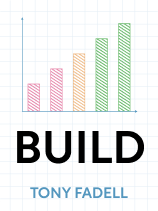

This article is an excerpt from the Shortform book guide to "Build" by Tony Fadell. Shortform has the world's best summaries and analyses of books you should be reading.
Like this article? Sign up for a free trial here.
What are the secrets to being successful in your career? What’s the best way to start? How can you finish strong?
Entrepreneur Tony Fadell answers these questions and more in Build. The book is part career encyclopedia and part memoir, detailing Fadell’s extraordinary journey inventing the iPhone and then starting his own wildly successful companies. He shares the career lessons he learned along the way.
Read more to learn how to build your career, from the bottom to the top.
How to Build Your Career
We’ll share Fadell’s tips on how to build your career, covering three stages of your professional life: when you’re starting out, when you’re managing, and when you’re CEO.
How to Start Your Career
The first step to creating a successful career, according to Fadell, is to figure out what you want to do. This doesn’t entail a specific salary or position; rather, ask yourself: What “mission,” or objective, inspires me to learn?
Second, Fadell recommends that you work for the right company. It should be working toward an objective similar to yours, have an original solution to an everyday problem experienced by the masses, and have the technical know-how to successfully create the product they’re promising. Ideally, the experts in your field will be working there and the company is small enough that you can learn from them—fewer than 100 people is ideal. If a company fits all these criteria, don’t worry about your exact position. You can always switch internally within the company, but you can’t manufacture passion for an objective.
Third, Fadell suggests that you pay attention to the broader goals of the company. Instead of focusing exclusively on your short-term goals, occasionally shift your perspective so you can assess how your job fits into the company’s long-term goals, how you can do your job better, and notice any potential landmines that could harm the company. To do so, talk to your colleagues: your internal customers (the colleagues you send deliverables to), the people for whom you are the internal customer, and the people who talk directly to the customer (like sales or customer service). Each of these teams has a different perspective; by talking to them, you’ll have a more well-rounded view of what’s going on and how you can better support the company’s (and your) objective.
Fourth, Fadell suggests that you know when to quit. At some point, you may realize that your company is not on track to fulfill the objective you share. If you see a major problem down the pipeline, point it out to your manager and offer a potential solution. If nobody does anything even after you’ve escalated the problem to the highest level you possibly can, leave, but make sure you don’t burn any bridges to keep your reputation intact.
How to Be a Good Manager
As you move further along in your career, you may be promoted to management. To be a good manager, Fadell contends that you must learn both how to manage people and how to manage decisions.
How to Manage People Well
Fadell argues that the key to managing people well is to find a balance between being hands-on and hanging back. As a manager, it’s your job to ensure that your team creates an amazing product—so be hands-on in service of that mission and push back if they’re not meeting your high expectations. But it’s not your job to nitpick about exactly how the team produces results—if you do, you’ll veer rapidly into inefficient micromanagement. So, hang back and let your team do what they do best. This will be easiest if you decide together at the beginning of the project how the team will create the product and then check in regularly on their progress.
How to Manage Decisions
Fadell argues that managing decisions well depends on understanding what type of decision you’re making. You’ll make two types of decisions: informed (or “data-driven”) decisions and instinctive (or “opinion-driven”) decisions. Informed decisions rely primarily on hard data, so they’ll be relatively easy to make. But instinctive decisions rely primarily on your own intuition. As such, they’re inherently risky and difficult to make, and they may invite pushback from leadership—who often want hard data to confirm that you’re making the right decision.
To deal with this pushback, Fadell recommends that you tell a good story. If you can convince leadership that you have all the data you could possibly get, that you’re a good decision-maker who knows the customer well, that you’re mindful of the risks involved, and that this decision could be good for the company, you’ll gain their approval.
How to Be a Good CEO
If you’re extremely successful, you may one day become CEO. If that happens, Fadell explains that your job is now to care about the company. Everybody in your company will now look to you for cues on how to behave, so pay attention to and demand high standards from every department: If you do, lower-level managers will also demand high standards from their employees.
Additionally, pay attention to developments outside the company. Don’t fall into the trap of thinking that any idea that your company didn’t come up with must be bad; if you do, you risk ignoring innovative technologies that could transform your field.
One day, you may need to decide whether to sell your company. If so, Fadell recommends taking into account three major factors. First, ensure that your long-term goals complement each other. Second, know exactly what potential benefits this merger will provide. Third, evaluate how well your cultures mesh together—if your core values are contradictory, you’ll face issues.
Exercise: Are You Working at the Right Company?
Fadell argues that if you want to build a successful startup, you must learn as much as you can by working at the right company. In this exercise, you’ll evaluate whether your current position is helping you pave the right path.
- What mission or objective are you chasing right now? Recall that Fadell’s mission was to create handheld computing devices.
- How is your current position helping you achieve that mission?
- If you’re satisfied with how your current position is helping you on your mission, how can you adjust it to be even more helpful? For example, Fadell recommends talking to other people in your company so that you can learn as much as possible about what you’re trying to do.
- If you’re dissatisfied with how your current position is helping you on your mission, what kind of changes could you make? For example, Fadell recommends looking for jobs at smaller companies in which you can learn from your mentors.

———End of Preview———
Like what you just read? Read the rest of the world's best book summary and analysis of Tony Fadell's "Build" at Shortform.
Here's what you'll find in our full Build summary:
- Entrepreneur Tony Fadell's memoir, from the iPhone to Nest
- Advice for succeeding in every stage of your career, from beginners to CEOs
- Tips for building a product-based business and a great team






